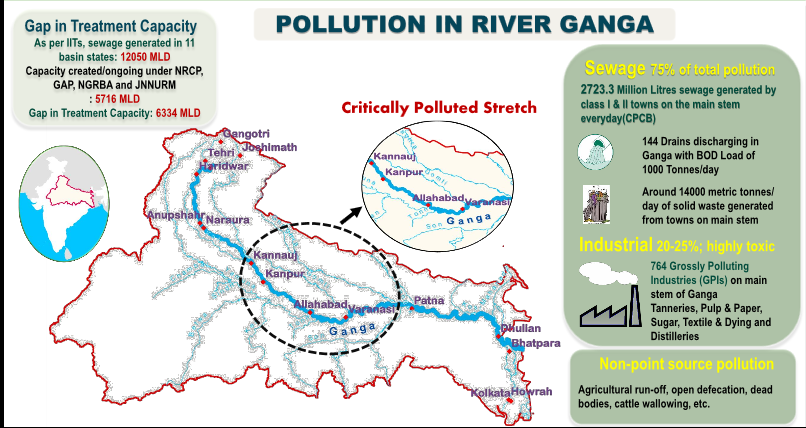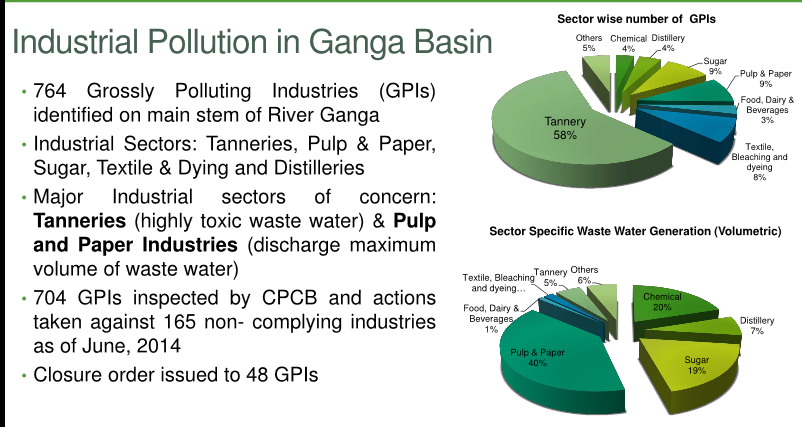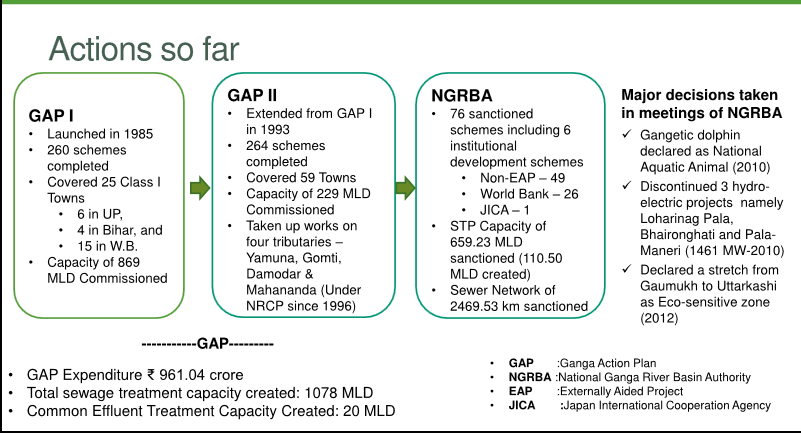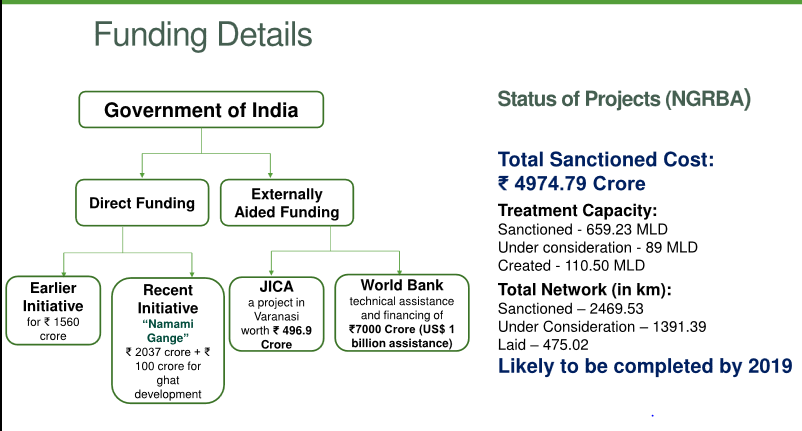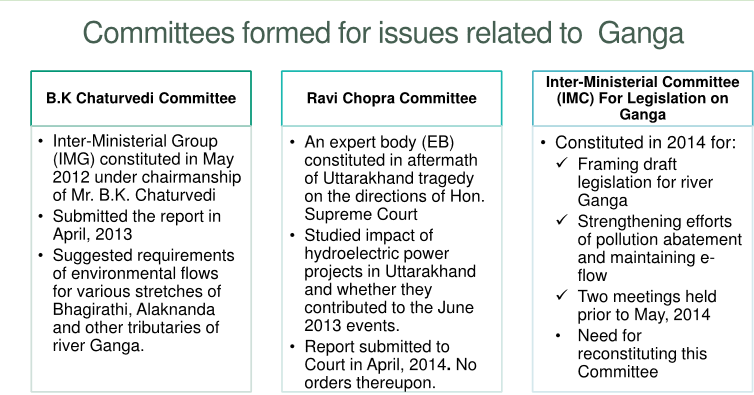Ganga (Ganges): cleaning the river
This is a collection of articles archived for the excellence of their content. |
Contents |
Pollution, level of
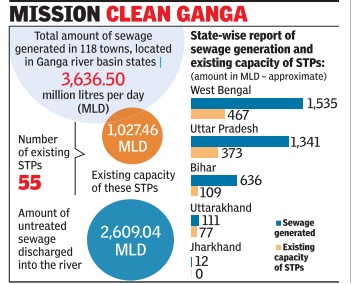
Carcinogenic waters?
A dip in Ganga may cause cancer
The Times of India TNN | Jun 25, 2014
HYDERABAD: A dip in river Ganga can possibly cause cancer. Though Prime Minister Narendra Modi had declared that cleaning Ganga was his top priority but more needs to be done than expected.
The Department of Atomic Energy's National Centre for Compositional Characterisation of Materials (NCCM) in Hyderabad has tested water samples from the Ganga and found the river water contained carcinogens. The NCCM which functions under the Bhabha Atomic Research Centre (BARC) collected water samples from the river during the Kumbha Mela in January 2013 and tested them.
It was found that the water collected by the devotees for puja contained Chromium 6. "Chromium is essential as well as toxic. The toxic form of chromium is hexavalent chromium. We have determined its content in the Ganga water collected during Kumbha Mela. It was 1 ng/ml, almost 50 times the permissible limit," NCCM head Dr Sunil Jai Kumar said. Being exposed to such high levels of chromium can result in health hazards, including cancer.
The impurities were said to have mainly come from the Kanpur tanneries. "We have to develop technologies that can cleanse the Ganga of chemical impurities. It can be done," said Sunil Jai Kumar responding to a query. A C Sahayam, who heads the bulk analysis wing at NCCM, demonstrated the system of purification of water containing carcinogens.
Sunil Jai Kumar explained the functioning of the National Centre for Compositional Characterisation of Materials (NCCM). He said the NCCM had also developed fluoride testing kits with which visual detection of fluoride would be possible. The government had transferred the technology to different companies and the kits were made available to the public at low cost.
From hospital waste like X-ray films, CDs, and batteries, the centre has also developed a method to extract silver.
The NCCM, which conducted studies at Moula Ali in Hyderabad six months ago, found that groundwater contained 100 times more mercury than permissible limits. Centre checks water on 22 parameters including heavy metal contaminants. "For the electronics industry, we have the technology to analyse high purity materials of 99.9999 per cent or more," Sunil Jai Kumar said
Sewage in Ganga

Apr 29 2015
Half the sewage in Ganga is from six cities along it
Vishwa Mohan
More than half the total sewage discharged into the Ganga every day comes from six big cities with Kolkata, Kanpur and Varanasi leading the pack.They are three of the 118 townscities that fall in the vast basin of the national river. Other top cities are Patna, Allahabad and Moradabad.
These cities present a gigantic task before the government which aims to bring them to a stage where each drop of sewage water generated can be used by different agencies including industries and municipal bodies after treatment.
The task, under the proposed `zero discharge policy', looks difficult as more than two-thirds of the sewage generated in these towns get discharged into the Ganga untreated.
A recent report, by a team of experts from different government agencies, has noted that these townscities collectively generate over 3,636 million litres per day (MLD) of sewage as against the treatment capacity of approximately 1027 MLD.
Underlining the `gap' between sewage generation and treatment capacity , the water resources and Ganga rejuvenation ministry has already asked all five states Uttarakhand, Uttar Pradesh, Bihar, Jharkhand and West Bengal to submit their detailed project reports to enhance treatment capacities of these townscities.
The government on Monday informed the Rajya Sabha that the National Mission for Clean Ganga (NMCG) has received expression of interest from a number of foreign governments (UK, Germany, Australia, Canada, Singapore, the Netherlands) to support Ganga rejuvenation through knowledge and technology sharing and financial assistance.
“The government has identified 118 towns along the river Ganga which discharge sewage into the river,“ the Union minister Uma Bharti said in her written reply to a Parliament question.
She said, “The Central Pollution Control Board is monitoring the water quality at 56 locations along the main stream of Ganga. In addition, the NMCG is getting water quality monitored.“
The report, highlighting the poor infrastructure of the 118 towns, was prepared by experts from six different organizations of the ministry including National Institute of Hydrology , Central Water Commission, National Water Development Agency and Central Ground Water Board. The team had submitted its report to the ministry in December, 2014.
NGT: Rafting on Ganga okay, not camping
The Times of India, Dec 11 2015
Seema Sharma
Rafting on Ganga okay but no camping: NGT
In a big blow to Ganga beach camp owners who were hoping for a reprieve, the National Green Tribunal upheld its ban on camping near the river from Kaudiyala to Rishikesh in Uttarakhand, an order passed in March, even as it allowed rafting.
The tribunal, which had in August cancelled fresh permission for beach camps, also asked the state forest department to constitute a committee to frame policy and furnish a report on capacity building in the area and the spots suitable for camping sites in future. A committee created by the NGT to report on capacity building near the Ganga from Kaudiyala to Rishikesh in Uttarakhand has been given three weeks to submit its report to the environment ministry. The ministry, in turn, has to take a decision on the issue in three weeks after the report is submitted. Vikram Tongad, who filed the original plea for ban, said, “ We wanted regulations and guidelines to be put in place for these beach camps which have mushroomed in the stretch.“
Diversion of water responsible
The Times of India, January 27, 2016
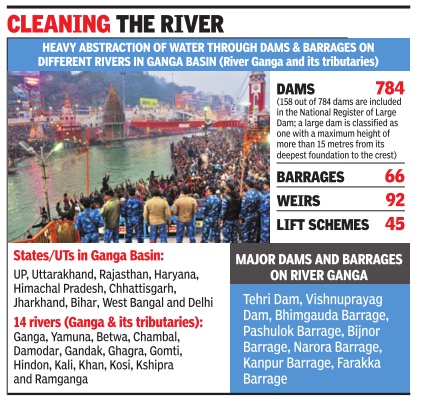
Vishwa Mohan
Diversion of water must stop to curb Ganga's pollution: Report
Grappling with the mammoth task of cleaning the Ganga, the water resources ministry has flagged how “heavy abstraction“ of water has become a key concern in its efforts to rejuvenate the river at a time when it has already moved to handle pollution hrough multiple measures. The ministry made a detailed presentation over the issue in the Prime Minister's Office early this month, flagging how water is diver ed from Ganga to meet demands of agricututre, industries, domestic consumption and power genera ion through 784 dams, 66 barrages, 92 weirs and 45 lift irrigation schemes on the country's national river and its tributaries.
In its 86-page presentation -Challenges and Required Interven ions -the ministry also made a case for maintaining minimum flow of water in Ganga as the river has a self-cleansing ability , provided it has uninterrupted flow of water round the year. Uninterrupted flow of water is possible only if the river gets its ecological flow (e-flow). The e-flow of a particular river refers to quality, quantity and timing of water flows required to maintain the functions, processes and resilience of aquatic eco-systems.
The PMO was also briefed over the differences of opinion of two ministries over the issue of construction of dams on Ganga and its tributaries. While the water resources ministry does not want any new dam so that Ganga gets its e-flow, the environment ministry has recently conditionally allowed five new dams on its tributaries in Uttarakhand and filed an affidavit in this regard in the Supreme Court.
“You cannot clean the river only by setting up sewage treatment plants and asking industries to stop discharging untreated water. If you don't deal with abstraction of water, the Rs 20,000 crore plan would go down the drain the way the Centre had lost nearly Rs 5,000 crore in the past,“ an official said.
Even a letter by water resources minister Uma Bharti to environment minister Prakash Javadekar failed to cut the deadlock. Though the environment ministry has put a condition while specifying how much minimum water should be enough to maintain uniterrupted flow in Ganga, the water ministry does not appear to be convinced.
“To take care of irrigation needs of farmers, the government has planned to promote drip irrigation and other methods for optimum utilisation of water under its `per drop, more crop' goal,“ said the official.
Ganga in Haridwar unfit for bathing
`Ganga in Haridwar unfit even for bathing', May 18, 2017: The Times of India
A dip in the Ganga may wash away your sins but the river's water is also likely to make you sick. The Central Pollution Control Board's reply to an RTI query put up by TOI has said that the water of the river along Haridwar is not fit even for bathing.
The CPCB has said that water in Haridwar district fails almost all parameters of safety. According to official sources, nearly 50,000-1 lakh devotees bathe at the over 20 ghats of Haridwar every day .Tests were done at 11locations in Uttarakhand, from Gangotri to Haridwar, a distance of 294km along the river. The RTI filed sought details of water quality and locations from which samples are collected. RM Bhardwaj, senior scientist of the CPCB, stated that four main indica tors of river water quality were taken into account when examining the 296 km stretch. These included temperature, dissolved oxygen (DO), biological oxygen demand (BOD) and coliform (bacteria).Clinical tests of water samples showed high levels of BOD, coliform and other toxic materials around Haridwar district.
According to CPCB norms, BOD levels should be less than 3 mg per litre for bathing purposes. But the levels go up to 6.4 mg per litre in the river's water.
Presence of high-level coliform fur ther threw light on the severity of water pollution in Haridwar. The total coliform value here is between 90 MPN (most probable number) per 100 ml to 1,600 MPN per 100 ml. According to the CPCB report, the coliform values should be 500 MPN100ml or less for bathing purposes.
Moreover, the acceptable limit for DO is 5 mg per litre or more but in Haridwar it is 4 mg to 10.6 mg per litre. Noted environmentalist Anil Joshi said, “Haridwar has emerged as an industrial and tourist hub and unless sewage treatment plants (STP) are installed and water discharge quality is monitored strictly , the ghats will continue to remain polluted.“
Initiatives to clean
Plastic use banned from Gomukh to Haridwar
The Times of India, Dec 11 2015
Seema Sharma
Tribunal bans plastic use from Gomukh to Haridwar in Ganga
There will be a complete ban on use of plastic of any kind from Gomukh to Haridwar along the Ganga with effect from February 1, the National Green Tribunal directed on Thursday while slapping a penalty of Rs 5,000 per day on erring hotels, dharamshalas and ashrams spewing waste into the river.
The decision taken by the bench, headed by NGT chairperson Justice Swatanter Kumar, also held that polluting ndustries operating without consent from Uttarakhand Environment Protection and Pol ution Control Board shall be closed with immediate effect.
Vinod Singhal, member secretary UEPPCB, told TOI, “The UEPPCB has already enacted a law banning use of polythene of 40 microne or below. However, it was not properly implemented. However, the execution of the NGT order lies with the municipal corporation or local bodies which is the statutory body in this regard.“
The green panel divided cleaning work of the Ganga into different segments -Gomukh to Haridwar, Haridwar to Kanpur, Kanpur to UP bor der, UP border to border of Jharkhand and border of Jharkhand to Bay of Bengal.
The tribunal also prohibited throwing of any construction and demolition wastes into Ganga and its tributaries, failing which violators will have to pay a compensation of Rs 5,000 per incident. On the issue of mining on the river bed, the NGT said it shall be carried under strict supervision. “No mechanised river bed mining would be permitted. No JCBs would be permitted to operate on the river bed,“ it said.
Plastic: Complete ban along Ganga in Uttarakhand
The National Green Tribunal imposed a complete ban on Friday on the use, sale, purchase and storage of plastic items like bags, plates and cutlery in towns located along the banks of the Ganga from Haridwar to Gangotri, a stretch of about 140 kilometres. Major tourist attractions like Haridwar’s Har-Ki-Pauri ghat and Rishikeshfall under the purview of the ban.
The bench headed by NGT chairperson justice Swatanter Kumar said that a fine of Rs 5,000 would be imposed on violators. He added that action would be taken against erring officials too. The tribunal also banned the sale, manufacture and storage of plastic till Uttarkashi from where the Ganga originates.
The NGT passed the order after observing that despite its earlier order, plastic was still being used in the Haridwar-Gangotri stretch. The panel had asked the state government in 2015 to ensure ban on sale of plastic bottles near the Ganga from Gaumukh to Haridwar. The state had imposed a ban on sale, use and storage of plastic bags, cups, glasses, packing material in the state after the Uttarakhand high court directed it to do so in December 2016.
The plastic ban, however, remains only on paper. Earlier this month, TOI reported that plastic containers were being sold at Har-ki-Pauri and other Ganga ghats as usual and that tea shops and restaurants were freely using plastic plates and tumblers. Many tourists seemed unaware of the ban. The NGT’s order re-enforcing the ban came on Friday while the bench was hearing a plea which alleged non-biodegradable plastic was affecting the river.
The Namami Gange programme/ 2015
Administrative hurdles along the course
Vishwa Mohan, BJP win may give Ganga a new life, Mar 13 2017 : The Times of India (Delhi)
The progress of the Namami Gange programme, May 2015-Dec 2016
Prime Minister Narendra Modi's ambitious `Namami Gange' [O Ganga, I salute you] programme is devised in such a way that the states would not have to directly implement and operate the projects, there are many issues for which the local administration has to act to make the mission a success in a time-bound manner.
The Centre had in May 2015 approved the flagship “Namami Gange“ programme which integrates the efforts to clean and protect the Ganga in a comprehensive manner. It has a budget outlay of Rs 20,000 crore for five years (2015-20).
“Since Uttarakhand (from where the Ganga origi nates) will now be ruled by the same party in the state and at the Centre, it would hopefully be easier to bring all stakeholders on the same page,“ said an official.
He said maintaining uninterrupted flow of the river is a prerequisite for naturally cleaning the river, but the issue had failed to convince Uttarakhand which had been pushing for new dams on the Ganga -an obstacle to the flow.
Uttar Pradesh, on the other hand, has to act against polluting industries and handle sewage at multiple levels before it is discharged into the river along its 1,000 km stretch. More than half of the river stretch passes through Uttarakhand and UP together.
Jharkhand is the third BJP-ruled state where the ongoing Ganga cleaning mission is at different stages of implementation. The other two states on the main stem of the river are Bihar (ruled by JD(U)-RJD-Congress alliance) and West Bengal (ruled by Trinamool Congress).
2017: the status of the cleaning- up efforts

See graphic:
Status of the cleaning-up efforts, May 2017
2018: Centre norms for uninterrupted flow of Ganga
Centre notifies norms for uninterrupted flow of Ganga, October 11, 2018: The Times of India

From: Centre notifies norms for uninterrupted flow of Ganga, October 11, 2018: The Times of India
In order to restore and maintain continuous flow of river Ganga, the Centre has notified minimum environmental flow (e-flow) for the river that has to be maintained at various locations. Uninterrupted flow of water in any river is important to keep it clean through its natural ecological functions and processes.
Any dam or structure meant for diversion of river flows for the purpose of irrigation, hydro-power and domestic or industrial use will now have to maintain the minimum flow under the notification. There are 784 dams, 66 barrages, 92 weirs and 45 functional lift schemes located, at present, in the Ganga river basin.
All existing projects, which currently do not meet the norms, will have to comply with it within three years. However mini and micro projects, which do not alter the flow characteristics of the river or stream significantly, are exempted from these environmental flow norms.
Meanwhile, the Union water resources ministry will soon send a proposed law on river Ganga—the draft Ganga Act which provides for jail terms and fine to polluters and those who obstruct its flow— to the Cabinet for approval.
“This is a very significant moment. The discussions on notifying e-flow of Ganga have been going on for a long time. We have taken this step to ensure a minimum amount of flow in the river”, said Union water resources minister Nitin Gadkari.
He said, “The notification will go a long way in ensuring the river Ganga’s ‘Aviralta’ or continuous flow.”
On the issue of construction of hydro-power projects in Uttarakhand, Gadkari said that views of various stakeholders were being taken and a considered decision would then be taken in this regard.
The notification is issued in the backdrop of ongoing ‘fast unto death’ by environmentalist and former IIT Kanpur faculty member G D Agarwal at Haridwar on issue of Ganga conservation. The 87-year-old Agrawal has been observing hunger strike since June 22 for pollution free and uninterrupted flow in the Ganga.
Many environmentalists had long been demanding such provisions which ensure uninterrupted flow of the river. The e-flows are the acceptable flow regimes that are required to maintain a river in the desired environmental state.
The minimum e-flow norms will apply to the upper Ganga River Basin - starting from originating glaciers and through respective confluences of its head tributaries which meet at Devaprayag up to Haridwar - and the main stem of the river Ganga up to Unnao district of Uttar Pradesh.
Under the notification, the flow conditions in these river reaches will be monitored at hourly intervals from time to time. The Central Water Commission (CWC) will be the designated authority and the custodian of the data. It will be responsible for supervision, monitoring, regulation of flows. The CWC will also take emergent decisions about the water storage norms in case of any emergency.
According to notification, the concerned project developers or authorities will have to install automatic data acquisition and data transmission facilities at appropriate locations at project sites within six months.
“The central government through National Mission for Clean Ganga may direct release of additional water in the river Ganga to meet special demand as and when required,” it said.
See also
Ganga (Ganges): cleaning the river
